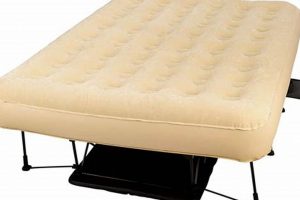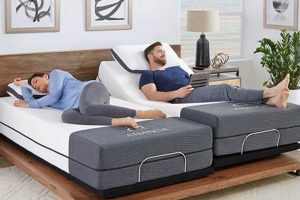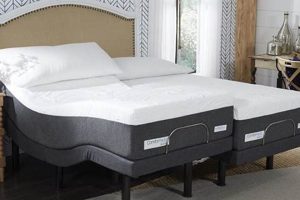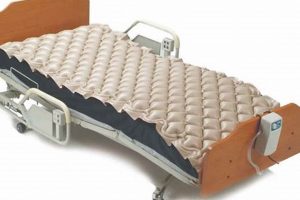A specialized cushioning system designed for installation within the sleeping compartment of commercial motor vehicles, providing a sleeping surface for drivers during rest periods. These systems typically conform to the dimensions of the sleeper berth in a tractor-trailer, offering a more comfortable alternative to the standard, often firm, factory-installed padding.
The utilization of enhanced in-cab sleeping arrangements is vital for driver health and safety, mitigating fatigue and promoting restful sleep, which is crucial for maintaining alertness during long-haul operations. The implementation of these systems contributes to improved driver retention rates and reduced instances of accidents attributed to driver exhaustion. Historically, basic bedding options were standard, but growing awareness of health and safety issues has led to the development of advanced designs with improved comfort and support.
The following sections will delve into the various types available, factors influencing purchase decisions, maintenance procedures, and common problems encountered by users. A comprehensive understanding of these aspects facilitates informed selection and prolonged product lifespan.
Selection and Maintenance Recommendations
Optimal utilization and longevity of the product are contingent upon adherence to specific selection and maintenance practices. Proper understanding and implementation of these recommendations will maximize driver comfort and minimize potential complications.
Tip 1: Material Evaluation: Prioritize high-density foam or memory foam construction for superior support and pressure relief. Evaluate the material’s durability and resistance to compression over extended periods of use. Consider the breathability of the material to regulate temperature and moisture, especially in varying climates.
Tip 2: Size and Fit Verification: Accurately measure the dimensions of the sleeper berth before purchase. Ensure the selected unit precisely fits the available space to prevent shifting or gaps, which can compromise comfort and safety. Confirm compatibility with any existing sleeper berth features, such as storage compartments or access panels.
Tip 3: Cover Material Selection: Choose a cover material that is durable, water-resistant, and easy to clean. Hypoallergenic options are recommended to minimize the risk of allergic reactions. Regularly clean the cover according to the manufacturer’s instructions to prevent the accumulation of dirt, dust, and allergens.
Tip 4: Regular Rotation and Flipping: Implement a routine of rotating and flipping the unit to distribute wear and tear evenly. This practice helps prevent premature sagging and maintains consistent support across the entire surface. The frequency of rotation and flipping may vary depending on the material composition and usage patterns.
Tip 5: Proper Support System Inspection: Inspect the underlying support structure within the sleeper berth regularly for signs of damage or wear. Address any issues with the support system to prevent uneven weight distribution and potential damage to the unit. Reinforce or replace worn support components as necessary.
Tip 6: Addressing Moisture and Odor: Employ moisture-wicking bedding materials to minimize the accumulation of moisture within the unit. Utilize odor-absorbing products or baking soda to neutralize any unpleasant odors. Ensure adequate ventilation within the sleeper berth to promote air circulation and reduce the risk of mold or mildew growth.
Tip 7: Professional Cleaning Considerations: Consider professional cleaning services periodically to deep clean and sanitize the unit. Professional cleaning can remove embedded dirt, stains, and allergens that may not be addressed through routine cleaning methods. Follow the recommendations of the cleaning professional regarding suitable cleaning products and techniques.
Adherence to these selection and maintenance guidelines will contribute to extended product lifespan, improved driver well-being, and optimized performance throughout the operational life cycle. Diligent application of these strategies will ensure continued comfort and support during periods of rest.
The concluding section will present a summary of key considerations and future trends related to in-cab comfort and driver wellness.
1. Material Composition
Material composition is a primary determinant of the performance, durability, and comfort provided by in-cab bedding solutions. The selection of materials directly impacts pressure distribution, temperature regulation, and the overall longevity of the sleep surface. Understanding the properties of various materials is crucial for informed purchasing decisions.
- Foam Density and Support
Foam density is a critical factor influencing the level of support provided. High-density foams, such as high-resilience polyurethane or memory foam, offer superior support and resistance to compression. Insufficient density can lead to premature sagging and reduced pressure relief, increasing the risk of discomfort and musculoskeletal strain. The use of high-density foam is often correlated with improved driver comfort and reduced instances of back pain.
- Memory Foam Viscoelasticity
Memory foam, or viscoelastic polyurethane foam, exhibits unique properties that conform to the contours of the body, distributing weight evenly and reducing pressure points. The degree of viscoelasticity determines the foam’s responsiveness to temperature and pressure, influencing its ability to mold to the body and return to its original shape. Variances in viscoelasticity affect the overall comfort and support characteristics of the product. Lower quality memory foam might not provide adequate support over time.
- Innerspring Coil Gauge and Count
In innerspring units, the gauge and count of the coils are significant factors in determining support and durability. Lower gauge coils (thicker wires) offer greater resistance to compression, providing a firmer support surface. A higher coil count generally results in more uniform weight distribution and reduced motion transfer. Inadequate coil gauge or count can lead to uneven support and premature breakdown of the mattress structure.
- Latex Foam Elasticity and Resilience
Latex foam, derived from natural or synthetic rubber, offers excellent elasticity and resilience. Its open-cell structure promotes air circulation, contributing to temperature regulation. Natural latex is generally more durable and resistant to microbial growth compared to synthetic latex. The elasticity of latex foam allows it to quickly regain its shape after compression, providing consistent support over time.
In summary, the selection of materials, including foam density, memory foam viscoelasticity, innerspring coil specifications, and latex foam properties, are integral to the overall performance and longevity of in-cab bedding. The careful consideration of these factors ensures optimal comfort, support, and durab
ility, promoting driver well-being and contributing to safer operational practices.
2. Dimensional Accuracy
Dimensional accuracy is paramount in the context of in-cab bedding for commercial motor vehicles. Precise conformity to the sleeper berth dimensions is not merely a matter of convenience, but a critical determinant of safety, comfort, and the overall functionality of the sleeping environment. Deviations from specified measurements can lead to a range of adverse consequences.
- Optimal Space Utilization
Accurate dimensions maximize the usable space within the confined sleeper berth. A unit that is too large obstructs movement and storage, while one that is too small creates gaps that can lead to discomfort and potential hazards. Precise fitting ensures the full available area is effectively utilized for rest and relaxation. For example, a properly sized unit allows for unhindered access to storage compartments and facilitates ease of movement within the cab.
- Preventing Shifting and Instability
Dimensional discrepancies can cause the in-cab mattress to shift or slide during transit, particularly on uneven road surfaces. This instability not only disrupts sleep but also poses a safety risk, as the shifting weight can affect vehicle handling. Precisely sized units remain securely in place, minimizing the likelihood of movement and maintaining a stable sleeping surface. Real-world examples include units that slide into the space perfectly, removing gaps for safe sleep.
- Maintaining Ergonomic Support
Incorrect dimensions compromise the intended ergonomic support of the bedding system. Gaps or overhangs can create pressure points and misalignment, leading to discomfort, muscle strain, and potential long-term health issues. A dimensionally accurate unit provides consistent support across the entire surface, ensuring proper spinal alignment and reducing the risk of musculoskeletal problems. For instance, a custom mattress with precise size ensures drivers body always get supported ergonomically and reducing back pain.
- Ensuring Compatibility with Sleeper Berth Features
Modern sleeper berths often incorporate various features, such as storage compartments, ventilation systems, and integrated controls. Dimensional accuracy is essential for ensuring that the bedding does not interfere with the functionality of these features. Units that are too large or improperly shaped can obstruct access to storage, block ventilation openings, or damage integrated control panels. A product that is dimensionally perfect guarantees compatibility with existing berth functionalities, preserving their usability and effectiveness.
In conclusion, dimensional accuracy is not a trivial consideration but a fundamental requirement for in-cab bedding in commercial motor vehicles. The benefits of precise conformity extend beyond mere convenience, encompassing safety, comfort, ergonomic support, and compatibility with existing sleeper berth features. Attention to dimensional accuracy during the selection process is paramount to ensuring a safe and restful environment for drivers during periods of rest.
3. Support Technology
Support technology, as integrated within semi truck bed mattresses, fundamentally dictates the quality of sleep and the overall physical well-being of drivers. The effectiveness of this technology directly influences the distribution of pressure, the alignment of the spine, and the mitigation of motion transfer, all of which are critical factors in achieving restorative rest. Inadequate support systems can lead to discomfort, pain, and ultimately, fatigue, thereby compromising driver alertness and safety.
The evolution of support technology in this context has resulted in a variety of solutions, including innerspring systems, memory foam, and adjustable air chambers. Innerspring systems, characterized by interconnected coils, provide a more traditional support structure, offering varying degrees of firmness and responsiveness. Memory foam, a viscoelastic material, conforms to the contours of the body, reducing pressure points and promoting spinal alignment. Adjustable air chambers allow drivers to customize the firmness level, accommodating individual preferences and specific musculoskeletal needs. The choice of support technology should align with individual requirements, considering factors such as body weight, sleeping position, and pre-existing medical conditions. For example, drivers with chronic back pain may benefit from memory foam or adjustable air chamber systems that offer targeted support and pressure relief. Furthermore, some models now incorporate zonal support, where different sections of the mattress are engineered to provide varying levels of firmness, optimizing support for different body regions.
The practical significance of understanding the relationship between support technology and semi truck bed mattresses lies in its impact on driver safety and operational efficiency. By selecting a system that provides adequate support and promotes restful sleep, transportation companies can reduce the risk of accidents caused by driver fatigue and improve driver retention rates. Continued advancements in support technology are expected to further enhance the comfort and health benefits of in-cab bedding, contributing to a safer and more productive transportation industry.
4. Cover Durability
Cover durability, in the context of semi truck bed mattresses, is a critical attribute that directly impacts the longevity, hygiene, and overall performance of the bedding system. The cover serves as the first line of defense against wear and tear, spills, and the accumulation of contaminants, thereby influencing the comfort and health of the driver. Selection of appropriate cover materials and construction methods is essential for maximizing the lifespan and functionality of the mattress.
- Resistance to Abrasion and Tearing
The cover material must exhibit high resistance to abrasion and tearing due to the frequent use and potential for friction against clothing, bedding, and other objects within the sleeper berth. Materials such as heavy-duty polyester or nylon are often employed to withstand these stresses. Premature wear can lead to exposed internal components, compromising the integrity and comfort of the mattress. For example, covers constructed from reinforced fabrics are less susceptible to damage from routine use.
- Water Resistance and Stain Protection
The cover should possess water-resistant properties to protect the underlying mattress core from spills and moisture. Liquids can promote the growth of mold and mildew, leading to unpleasant odors and potential health hazards. Stain-resistant coatings further enhance the cover’s ability to repel spills and facilitate easy cleaning. In commercial applications, where spills are more likely, a water-resistant and stain-protected cover is imperative for maintaining hygiene and extending the lifespan of the unit.
- Breathability and Ventilation
While providing protection, the cover must also allow for adequate breathability
and ventilation to prevent the accumulation of heat and moisture. Non-breathable materials can trap perspiration, creating an uncomfortable sleeping environment and promoting the growth of bacteria. Fabrics with open weaves or specialized coatings that allow for air circulation are preferred. For instance, covers incorporating mesh panels can enhance ventilation and regulate temperature within the bed. - Ease of Cleaning and Maintenance
The cover should be easily removable and machine washable to facilitate regular cleaning and maintenance. Removable covers allow for thorough cleaning and disinfection, removing allergens, dust mites, and other contaminants. Easy-to-clean materials reduce the effort required to maintain hygiene and prolong the lifespan of the unit. Covers with zippers or other convenient closures simplify the removal and reinstallation process, making regular cleaning more practical.
In summary, cover durability is a multifaceted attribute that significantly influences the performance and longevity of semi truck bed mattresses. By selecting cover materials and construction methods that prioritize abrasion resistance, water resistance, breathability, and ease of cleaning, the lifespan of mattress will be prolong, drivers will have safe, confortable and healty sleep.
5. Ergonomic Design
Ergonomic design, when applied to semi truck bed mattresses, directly addresses the unique physical demands placed upon professional drivers. Prolonged periods of driving and irregular sleep schedules contribute to musculoskeletal disorders and chronic fatigue. The incorporation of ergonomic principles into mattress design aims to mitigate these risks by promoting proper spinal alignment, pressure distribution, and overall support, thereby improving sleep quality and reducing physical strain. The failure to incorporate ergonomic considerations can result in increased driver discomfort, decreased alertness, and a heightened risk of accidents.
Specific ergonomic features in these mattresses include zoned support systems, which provide targeted cushioning to different areas of the body, such as the lumbar region and shoulders. Memory foam and latex materials are often utilized for their conforming properties, which help to distribute weight evenly and reduce pressure points. Adjustable firmness settings allow drivers to customize the mattress to their individual needs and preferences. Real-world examples of ergonomically designed mattresses include those incorporating integrated lumbar support, designed to maintain the natural curvature of the spine, and those with temperature-regulating materials to promote a comfortable sleep environment. Furthermore, research indicates that ergonomically designed mattresses contribute to reduced back pain, improved sleep duration, and enhanced driver performance.
The practical significance of understanding the link between ergonomic design and semi truck bed mattresses lies in its potential to improve driver health, safety, and retention. By investing in mattresses that prioritize ergonomic principles, trucking companies can reduce the incidence of work-related injuries, improve driver satisfaction, and decrease turnover rates. Addressing the ergonomic needs of drivers is not merely a matter of comfort but a crucial factor in promoting a safer and more efficient transportation industry. Challenges remain in ensuring that all drivers have access to ergonomically sound mattresses and in raising awareness about the importance of ergonomic considerations in the selection and use of in-cab bedding.
Frequently Asked Questions
This section addresses common inquiries regarding in-cab bedding for commercial motor vehicles. The information provided aims to clarify key aspects and assist in informed decision-making.
Question 1: What distinguishes a semi truck bed mattress from a standard residential mattress?
Specialized units are designed to fit the specific dimensions of a truck’s sleeper berth. They are often constructed with materials that withstand the rigors of over-the-road use, including temperature fluctuations and constant vibration. Furthermore, dimensions are tailored to fit sleeper cab size. Residential mattresses lack those features.
Question 2: How does the unit contribute to driver health and safety?
Adequate sleep is crucial for alertness and cognitive function. A comfortable, supportive surface promotes restful sleep, mitigating fatigue and reducing the risk of accidents. Therefore, a proper unit is important for truck drivers.
Question 3: What are the key considerations when selecting a mattress for a commercial vehicle?
Factors include dimensions, material composition (foam density, coil count), support technology (memory foam, innerspring), cover durability (water resistance, breathability), and ergonomic design (spinal alignment). All of these aspects should be accounted for.
Question 4: How often should a replacement be considered?
Replacement frequency depends on usage, material quality, and maintenance. Indications of wear include sagging, loss of support, and persistent odors. A replacement timeline can be from 3-5 years based on usage.
Question 5: What cleaning and maintenance procedures are recommended?
Regular vacuuming, spot cleaning, and cover washing are essential. Utilize appropriate cleaning solutions and follow manufacturer instructions. Proper use will prolong the life of the product.
Question 6: Are there regulations governing the type of bedding permissible in commercial vehicles?
Regulations primarily focus on driver hours of service and rest requirements. While specific bedding standards are generally absent, adherence to safety guidelines and promoting driver well-being is implicit. Check for local state laws on safety.
The information presented offers a concise overview of common inquiries. Consult with manufacturers and industry experts for more detailed guidance.
The following section will discuss future trends.
Conclusion
This exploration has highlighted the critical role of the “semi truck bed mattress” in promoting driver health, safety, and operational efficiency within the commercial transportation industry. The selection of appropriate materials, precise dimensional fit, advanced support technology, durable cover construction, and ergonomic design principles are paramount for optimizing sleep quality and mitigating the physical demands associated with long-haul driving. A thorough understanding of these factors is essential for informed purchasing decisions and effective maintenance practices.
Continued advancements in materials science, ergonomic design, and sensor technology hold promise for future enhancements in in-cab bedding. Transportation companies and drivers should prioritize investment in high-quality “semi truck bed mattress” solutions to ensure driver well-being and contribute to a safer and more productive transportation ecosystem. Further research and development are warranted to address the evolving needs of the trucking industry and to optimize the design and performance of in-cab bedding systems.


![Best Car Inflatable Mattress Air Bed [Sleep Easy!] Organic & Natural Mattress Buyer’s Guide: Non-Toxic Sleep Solutions Best Car Inflatable Mattress Air Bed [Sleep Easy!] | Organic & Natural Mattress Buyer’s Guide: Non-Toxic Sleep Solutions](https://mattressworldpa.com/wp-content/uploads/2025/07/th-7003-300x200.jpg)




![Ultimate Ottoman King Size Bed & Mattress Set [Sleep Easy] Organic & Natural Mattress Buyer’s Guide: Non-Toxic Sleep Solutions Ultimate Ottoman King Size Bed & Mattress Set [Sleep Easy] | Organic & Natural Mattress Buyer’s Guide: Non-Toxic Sleep Solutions](https://mattressworldpa.com/wp-content/uploads/2025/07/th-6998-300x200.jpg)